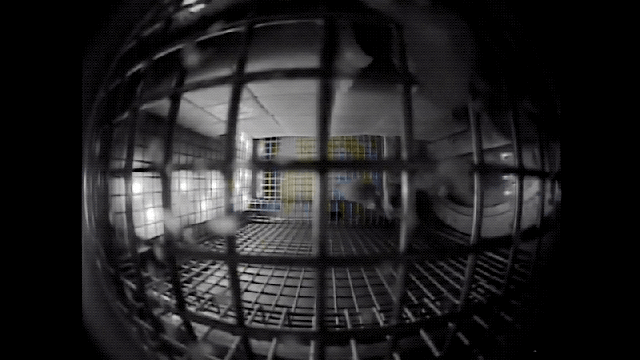New research based on experiments done on the International Space Station shows that mice adapt quickly to microgravity conditions. Unexpectedly, however, some of the mice began to exhibit a rather curious circling behaviour, zipping around the walls of their metal cage with reckless abandon.
New research published today in Scientific Reports is providing the most comprehensive analysis to date on the behaviour of mice in space. Studies of mice in space have been done before, including experiments done on the Space Shuttle, but the primary point of those efforts was to assess the viability of working with mice in microgravity. This new study actually took a look at their behaviour, and also some aspects of their health.
The new study, led by April Ronca from NASA Ames Research Center in Moffett Field, California, made use of the NASA Rodent Habitat (RH)—a caged enclosure designed specifically for the experiment. In a series of experiments done back in 2014 aboard the International Space Station, 20 mice were exposed to conditions typically experienced by astronauts, including microgravity, radiation, confinement, increased carbon dioxide, and other factors that could potentially influence health and psychological well-being.
And indeed, the primary point of the new study was to assess how mice, with their relatively short lives, respond to long-duration space missions. The resulting insights could tell us a bit more about how humans respond to similar conditions.
The mice used in the experiment were all female and either 16 or 32 weeks old when they departed Earth. After a four-day journey to the ISS aboard an uncrewed SpaceX Dragon capsule, the mice spent between 17 and 37 days in space. That’s a relatively brief stint for a human. For mice, however, who don’t live much past three years, that duration represented an extended stay.
A key focus of the new study was to examine the behaviour of mice in space. To that end, a series of cameras were set up to film the mice inside the RH. A duplicate of the experiment was set up on Earth to serve as the control group.
All 20 mice survived their respective mission durations. After returning to Earth, they appeared to be in good health, featuring body weights similar to those in the control group. The researchers also reviewed the video, taking notes on the mice’s behaviour.
For the most part, and after a few awkward first steps in microgravity, the mice showed a remarkable ability to adapt. The spaceflown mice engaged in typical behaviours, like eating, self-grooming, and cuddling with others. They explored their cage, occupied all its areas, and even followed a normal circadian sleep pattern. An interesting behavioural difference was that the younger mice were more physically active compared to their cohorts on Earth.
“Qualitative observations indicated that spaceflight mice readily adapted to the RH, propelling their bodies freely and actively throughout the habitat, utilising the entire volume of space available to them,” wrote the authors in the study. “Over time, the spaceflight mice began to move more quickly throughout the habitat, translating with ease through open spaces, but also anchoring their bodies using tails and/or paws.”
Around seven to 10 days into the experiment, the younger mice, but not the older mice, began to circle the cage in what the researchers described as “race-tracking” behaviour. A common pattern would see a lone mouse engaging in the behaviour, which then inspired a coordinated group activity.
The researchers aren’t entirely sure why the young mice are apt to do this, but a number of possibilities were presented in the study.
It might be an abnormal repetitive behaviour (ARBs), the result of, and a response to, boring, cramped conditions. ARBs, the authors wrote, are “generally thought to reflect impaired welfare as they tend to spontaneously appear in barren or restricted housing conditions.” Common ARBs that have been observed in other animals include “pacing in birds, prosimians [e.g. lemurs and tarsiers] and large carnivores, crib- and bar-biting in horses, pigs and mice, vertical jumping in mice, rocking in primates, and self-injurious behaviours in parrots and primates.”
The behaviour could be a stress response to microgravity — a way to stimulate their disrupted sense of balance.
Another, perhaps obvious, possibility has to do with how the behaviour resembles mice running on wheels. Theories behind this behaviour include a form of entertainment, or a form of exercise that’s rewarded with a satisfying squirt of dopamine in the brain. Or, it could be the expression of another ARB.
All that said, the researchers aren’t entirely sure why the mice are doing it, and they admitted more research is needed. But as strange and unexplainable as this circling behaviour was, the researchers said it wasn’t completely outside the realm of human experience.
“Affording mice the opportunity to grab and run in the RH resembles physical activities that the crew participate in routinely,” the authors wrote. “Our approach is yielding an interesting analogue for better understanding human responses to spaceflight, and providing the opportunity to begin to address how physical movement influences responses to microgravity.”
Which is a fair point. Astronauts enjoy and find it useful to coast around from point to point on the ISS, as do participants of weightless zero gravity flights on aeroplanes. In their own, curious way, the mice were acting quite human-like in what must’ve been a very strange situation for them.
